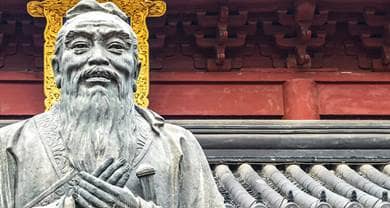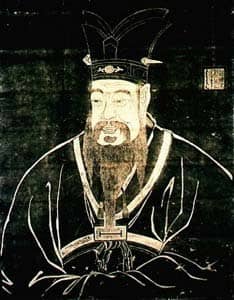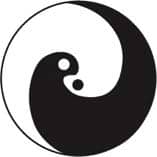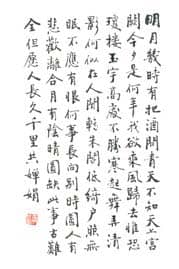- Trending:
- Pope Leo Xiv
- |
- Israel
- |
- Trump
- |
- Social Justice
- |
- Peace
- |
- Love

RELIGION LIBRARY
Confucianism
Symbolism
Symbols specific to Confucianism are relatively rare, and almost always pertain to scholarship. Stylized images of Kongzi attired as a scholar are often seen, and sometimes images of his scholar-disciples are also portrayed in paintings or statues. Motifs such as the "six arts" of the scholar are sometimes seen in works of art.
 Images of Kongzi and other Confucian saints have been widely circulated since the establishment of the first Confucian temples during the Han dynasty (202 B.C.E.–220 C.E.). Such images usually depict Kongzi and others in poses of meditative calm or in the act of teaching, attired in the garb of imperial court ministers, and carrying formal tablets signifying their offices. Kongzi himself is never depicted as anything other than an elderly man, and he usually is accompanied by his disciples, especially his beloved student Yan Hui. More rarely, he is pictured alongside his wife. One famous scene, often depicted in both temple images and "secular" art, is the meeting of Kongzi with the legendary Taoist sage, Laozi, who was supposed to have been an expert on Zhou dynasty ritual. Such images attract offerings and prayers from those who visit Confucian temples, often students seeking supernatural aid as they contend with the rigorous university entrance tests that are the last vestige of the old Confucian civil service examination system.
Images of Kongzi and other Confucian saints have been widely circulated since the establishment of the first Confucian temples during the Han dynasty (202 B.C.E.–220 C.E.). Such images usually depict Kongzi and others in poses of meditative calm or in the act of teaching, attired in the garb of imperial court ministers, and carrying formal tablets signifying their offices. Kongzi himself is never depicted as anything other than an elderly man, and he usually is accompanied by his disciples, especially his beloved student Yan Hui. More rarely, he is pictured alongside his wife. One famous scene, often depicted in both temple images and "secular" art, is the meeting of Kongzi with the legendary Taoist sage, Laozi, who was supposed to have been an expert on Zhou dynasty ritual. Such images attract offerings and prayers from those who visit Confucian temples, often students seeking supernatural aid as they contend with the rigorous university entrance tests that are the last vestige of the old Confucian civil service examination system.
 A symbol that is widely recognized in the West, albeit usually as a Taoist symbol rather than a Confucian one, is the stylized depiction of the interaction of yin and yang known as the Taiji (Great Ultimate). While no one knows exactly when this symbol first emerged, or who was responsible for its creation, it has become one of the most enduring and poignant images of East Asian religious culture, claimed by practitioners of all traditions. Confucians have been no exception to this rule. During the Song dynasty, the "Neo-Confucians" Shao Yong (1011-1077 C.E.) and Zhou Dunyi developed an elaborate interpretation of this symbol in accordance with their theories about how the primal qi of the cosmos becomes refined according to the patterning of li, especially within the heart-mind of one who practices Confucian self-cultivation. Zhou's Taijitu shuo (Explanation of the Diagram of the Great Ultimate) adapted what had been introduced to them as a Taoist image for Confucian purposes. Several Song and Ming dynasty Confucians developed their own interpretations of the Taiji symbol, including Liu Mu (1011-1064 C.E.) and Zhao Huiqian (1351-1395 C.E.).
A symbol that is widely recognized in the West, albeit usually as a Taoist symbol rather than a Confucian one, is the stylized depiction of the interaction of yin and yang known as the Taiji (Great Ultimate). While no one knows exactly when this symbol first emerged, or who was responsible for its creation, it has become one of the most enduring and poignant images of East Asian religious culture, claimed by practitioners of all traditions. Confucians have been no exception to this rule. During the Song dynasty, the "Neo-Confucians" Shao Yong (1011-1077 C.E.) and Zhou Dunyi developed an elaborate interpretation of this symbol in accordance with their theories about how the primal qi of the cosmos becomes refined according to the patterning of li, especially within the heart-mind of one who practices Confucian self-cultivation. Zhou's Taijitu shuo (Explanation of the Diagram of the Great Ultimate) adapted what had been introduced to them as a Taoist image for Confucian purposes. Several Song and Ming dynasty Confucians developed their own interpretations of the Taiji symbol, including Liu Mu (1011-1064 C.E.) and Zhao Huiqian (1351-1395 C.E.).
 The "six arts" were required learning for those who aspired to elite status in the Zhou dynasty, and images of young men practicing ritual, music, archery, chariot-driving, calligraphy, and mathematics can be found in Confucian art. Ritual, music, and calligraphy have remained powerful symbols of Confucian self-cultivation, and to this day, Confucian scholars often pride themselves on their attainments in these arenas. Just as the moral order of the universe (li) is said to be inscribed on the human heart-mind, so too is one's calligraphy thought to reveal the nature of one's heart-mind within, and the extent to which it communes with its cosmic source.
The "six arts" were required learning for those who aspired to elite status in the Zhou dynasty, and images of young men practicing ritual, music, archery, chariot-driving, calligraphy, and mathematics can be found in Confucian art. Ritual, music, and calligraphy have remained powerful symbols of Confucian self-cultivation, and to this day, Confucian scholars often pride themselves on their attainments in these arenas. Just as the moral order of the universe (li) is said to be inscribed on the human heart-mind, so too is one's calligraphy thought to reveal the nature of one's heart-mind within, and the extent to which it communes with its cosmic source.
Study Questions:
1. How has Confucius been depicted in art?
2. What is the Confucian interpretation of yin-yang symbolism?
3. What were the "six arts"?










